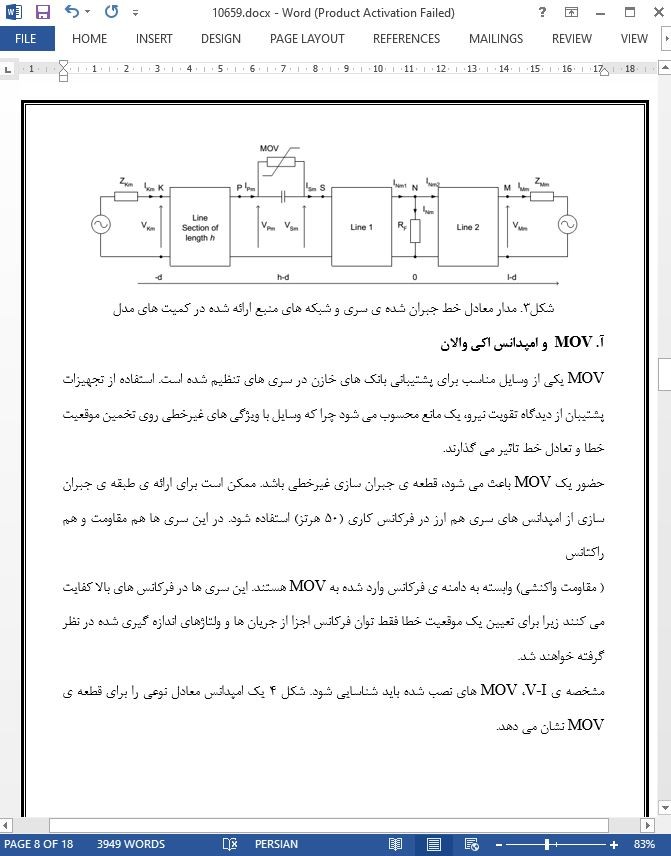
روش جدید تعیین موقعیت خطای دوپایانه ایی آسنکرون در خطوط جبران شده سری
چکیده
این مقاله مرتبط به موقعیت خطا در ولتاژهای بالای خطوط جبران شد ی سری است. یک روش جدید برای ارزیابی مسافت خطا پیشنهاد شده است. پارامترهای مربوط به معادلات خط برای توصیف خطوط ارائه شده اند. الگوریتم از اندازه گیری های دو پایانه ی خط استفاده می کند و به داده های سنکرون نیازی ندارد. هیچ اطلاعاتی در مورد مقدار مقاومت خطا و نوع خطا لازم نیست. آزمون های عددی با اندازه گیری نمونه ها در یک محدوده ی زمانی اجرا شد. شبیه سازی ها با استفاده از EMTP-ATP انجام شد. نتایج برای مقاومت محل خطاهای مختلف و مقدار فاصله ی خطا و شرایط نوع خطا گزارش شد.
1.مقدمه
شناسایی خطا و تخمین دقیق فاصله ی خطا برای خطوط انتقال با توان بالا در بازارهای آشفته ی الکتریسیته اهمیت دارد. روش های ممکن در مسئله ی موقعیت خطای دیجیتال، از داده های اندازه گیری شده در نرخ نمونه سازی پایین استفاده می کنند -که در این مقاله بر آن تمرکز خواهد شد- و می توانند به دو گروه اصلی تقسیم شوند. به این معنا که داده ی مورد استفاده در الگوریتم ها از یک پایانه ی خط انتقال است و دیگر داده های مورد استفاده از هر دو پایانه فراهم می شوند. یک فُرمر از دیدگاه اقتصادی عالی است زیرا به هیچ داده ایی برای انتقال، در طول مسافت های طولانی نیاز ندارد و داده های آن سنکرون نیستند. مورد دومی ( سنکرون نبودن) از دیدگاه دقت تعیین محل خطا عالی است اما به داده های منتقل شده از سیستم نیاز دارد.
5. نتایج
این مقاله با موقعیت خطا در خطوط تقویت شده ی سری در ارتباط است. در این مقاله از یک روش پیشرفته از معادلات خط استفاده شد تا ماهیت امپدانس ها و خازن های خطی را در مقابل با روش های تشکیل دهنده -که خط را به وسیله ی مجموعه امپدانس های سری توصیف می کند- نشان دهد. حضور یک عنصر غیر خطی در طول خط مثل خازن های سری و وسایل پشتیبانی آن مثل MOV اجازه نمی دهد که همانند روش تونن یک نمایش خطی وجود داشته باشد . به این دلیل، استفاده از الگوریتم موقعیت خطای دوپایانه پیشنهاد می شود. در یک روش کلی، فاصله ی خطا با استفاده از تئوری مدل تعیین می شود. روش پیشرفته به هیچ گونه دانشی از مقاومت و نوع خطا نیاز ندارد. فقط به پارامترهای خط و امپدانس های فصل مشترک شبکه های منبع در دو انتهای خط نیاز است. طبقه ی جبران سازی با وسیله ی پشتیبان می تواند به وسیله ی امپدانس معادل وابسته به جریان در یک توان متغیر ارائه شود.
Abstract
This paper deals with the fault location on high voltage series compensated lines. A new approach to evaluate the fault distance is proposed. The distributed-parameter line equations are preferred to describe the overhead lines. The algorithm uses two-terminal measurements, but those data do not require synchronization. No information on the fault resistance value and on the fault type is necessary. Numerical tests with time-domain sampled measurements are carried out. The simulations are performed using EMTP-ATP. Results for various fault resistance and fault distance values, and fault type conditions, are reported.
I. INTRODUCTION
dentification of a fault and accurate estimation of the fault distance become increasingly important for high power transmission lines in the deregulated electricity market. The possible approaches to the digital fault location problem using moderately low sampling rate of measured data, on which this paper will be focused, can be divided into two main groups, namely the algorithms using data from one terminal of a transmission line, and the other using data from both terminals. The former is superior in the economical point of view because it requires no data transfer along long distances and no data synchronization [11]. The latter is superior in the accuracy of fault location point of view, but requires a data transfer system.
V. CONCLUSIONS
This paper deals with fault location on series compensated lines. The developed method uses line equations taking into consideration the distributed nature of line impedances and capacitances in contrary to former methods that describe the line by a lumped series impedance. The presence of a non-linear element along the line, such as the series capacitance and its protective device MOV, does not allow linear representation such as the Thevenin method. For that reason a two-terminal fault location algorithm is proposed. The fault distance is determined in a general way using modal theory. The developed method does not need any knowledge of fault resistance and fault type. Only line parameters and the impedances of source networks interfacing the line at both ends are required. The compensation stage with the protection device can be represented by currentdependent equivalent impedance at power frequency.

چکیده
1.مقدمه
2. معادلات خط
3. روش موقعیت خطا
آ. MOV و امپدانس اکی والان
ب. معادلات برای تعیین موقعیت خطا
ث. کاربرد داده ی اندازه گیری شده ی آسنکرون
د. معیاری برای انتخاب راه حل صحیح
4. مثال های عددی و نتایج
5. نتایج
Abstract
I. INTRODUCTION
II. LINE EQUATIONS
III. FAULT LOCATION METHOD
A. MOV and equivalent impedance
B. Equations to determine the fault location
C. Use of unsynchronized measured data
D. Criterion for the selection of the correct solution
IV. NUMERICAL EXAMPLES AND RESULTS
V. CONCLUSIONS
- ترجمه فارسی مقاله با فرمت ورد (word) با قابلیت ویرایش، بدون آرم سایت ای ترجمه
- ترجمه فارسی مقاله با فرمت pdf، بدون آرم سایت ای ترجمه
